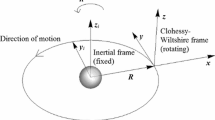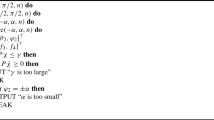Abstract
A second-order, general dynamics, relative motion framework is formulated to solve for optimal finite-burn transfers in complex gravity fields that are not amenable to analytic solutions. The second-order variational equations are employed in a Cartesian frame that is general in fidelity and simple to implement. For a passive chief orbit we show that only 16 coefficient functions are necessary to accommodate most dynamical environments of interest. We pre-compute and curve-fit the coefficient functions which represent the time-varying Jacobians and Hessians of the state equations evaluated along the chief orbit. Once the coefficient functions are evaluated, the resulting CUrve-fit quadRatic Variational Equations (CURVE) model is almost transparent to the fidelity level and therefore is well suited for the repeated iterations required by nonlinear optimization. The optimal control problem is solved using a robust, second-order technique that is a variant of differential dynamic programming. The model and optimal rendezvous problems are demonstrated in the highly perturbed dynamical environment of the Martian moon Deimos. The resulting implementation is useful for any relative motion application requiring optimal targeting, particularly in the context of complex force fields. While intended primarily for exotic destinations such as the Moon, asteroids, comets, and planetary satellites, the CURVE model and optimal control framework can also be useful for Earth orbiters, especially in cases of large eccentricity and high fidelity geopotentials.
Similar content being viewed by others
References
CLOHESSY, W.H. and WILTSHIRE, R.S. “Terminal Guidance System for Satellite Rendezvous,” Journal of the Aerospace Sciences, Vol. 27, No. 9, 1960, pp. 653–658.
HILL, G. “Researches in Lunar Theory,” American Journal of Mathematics, Vol. 1, 1878, pp.5-26.
WIESEL, W.E. “Relative Satellite Motion about an Oblate Planet,” Journal of Guidance, Control, and Dynamics, Vol. 25, No. 4, 2002, pp. 776–785.
MELTON, R. “Time-Explicit Representation of Relative Motion between Elliptical Orbits,” Journal of Guidance, Control, and Dynamics, Vol. 23, No. 4, 2000, pp. 604–610.
TSCHAUNER, J. and HEMPEL, P. “Rendezvous zu Einem in Elliptischer Bahn Umlaufenden Ziel,” Astronautica Acta, Vol. 11, No. 2, 1965, pp. 104–109.
INALHAN, G. and HOW, J. “Relative Dynamics and Control of Spacecraft Formations in Elliptic Orbits,” Journal of Guidance, Control, and Dynamics, Vol. 25, No. 1, 2002, pp. 48–59.
GURFIL, P. “Relative Motion between Elliptic Orbits: Generalized Boundedness Conditions and Optimal Formation Keeping,” Journal of Guidance, Control, and Dynamics, Vol. 28, No. 4, 2005, pp. 761–767.
PALMER, P.L. and IMRE, E. “Relative Motion between Satellites on Neighboring Keplerian Orbits,” Journal of Guidance, Control, and Dynamics, Vol. 30, No. 2, 2007, pp. 521-528.
SCHWEIGHART, S.A. and SEDWICK, R.J. “High Fidelity Linearized J2 Model for Satellite Formation Flight,” Journal of Guidance, Control and Dynamics, Vol. 25, No. 6, 2002, pp. 1073–1080.
SCHAUB, H. and ALFRIEND, K. T. “J2 Invariant Orbits for Spacecraft Formations,” Celestial Mechanics and Dynamical Astronomy, Vol. 79, 2001, pp. 77–95.
VADALI, S.R, SENGUPTA, P., YAN, H. and ALFRIEND, K.T. “Fundamental Frequencies of Satellite Relative Motion and Control of Formations,” Journal of Guidance, Control, and Dynamics, Vol. 31, No. 5, 2008, pp. 1239–1248.
GIM, D.W. and ALFRIEND, K. T. “State Transition Matrix of Relative Motion for the Perturbed Noncircular Reference Orbit,” Journal of Guidance, Control, and Dynamics, Vol. 26, No. 6, Nov.-Dec. 2003, pp. 956–971.
LEE, D., COCHRAN, J.E. and JO, J.H. “Solutions to the Variational Equations for Relative Motion of Satellites,” Journal of Guidance, Control and Dynamics, Vol. 30, No. 3, May-June 2007, pp. 669–678.
GURFIL, P. and KASDIN, N.J. “Nonlinear Modeling of Spacecraft Relative Motion in the Configuration Space,” Journal of Guidance, Control, and Dynamics, Vol. 27, No. 1, 2004, pp. 154–157.
VADDI, S.S, ALFRIEND, K.T., VADALI, S.R. and SENGUPTA, P. “Formation Establishment and Reconfiguration Using Impulsive Control,” Journal of Guidance, Control, and Dynamics, Vol. 28, No. 2, 2005, pp. 262–268.
IRVIN, D.J. JR., COBB, R.G. and LOVELL, A.T “Fuel-Optimal Maneuvers for Constrained Relative Satellite Orbits,” Journal of Guidance, Control, and Dynamics, Vol. 32, No. 3, 2009, pp. 960–973.
SCHEERES, D.J., HSIAO, F.Y. and VINH, N.X. “Stabilizing Motion Relative to an Unstable Orbit: Applications to Spacecraft Formation Flight,” Journal of Guidance, Control, and Dynamics, Vol. 26, No. 1, 2003, pp. 62–73.
LANTOINE, G. and EPENOY, R. “A Quadratically-Constrained Linear Quadratic Regulator Approach for Finite-Thrust Orbital Rendezvous,” Journal of Guidance, Control and Dynamics, Vol. 35, No. 6, 2012, pp. 1787–1797.
GONG, Q., ROSS, I. M. and ALFRIEND, K.T. “Triangle Formation Design in Eccentric Orbits,” presented as paper AIAA 2008–7360 at the 2008 AIAA/AAS Astrodynamics Conference, Honolulu, HI, 17–21 August 2008.
ROSS, I. M., KING, J. T. and FAHROO, F. “Designing Optimal Spacecraft Formations,” AIAA Paper 2002–4635, Monterey, CA, Aug. 2002.
ALFRIEND, K.T. and YAN, H. “Evaluation and Comparison of Relative Motion Theories,” Journal of Guidance, Control, and Dynamics, Vol. 28, No. 2, 2005, pp. 254–261.
ZUBER, M. “GRAIL Gravity Mission: Goals and Status,” Proceedings of the 37th COSPAR Scientific Assembly, Montréal, Canada., July 13–20, 2008, p. 3658.
LANTOINE, G. and RUSSELL, R. P. “Complete, Closed-Form Solutions of the Stark Problem,” Celestial Mechanics and Dynamical Astronomy, Vol. 109, No. 4, 2011, pp. 333–366, DOI 10.1007/s10569 - 010-9331-1.
SIMS, J.A. and FLANAGAN, S. N. “Preliminary Design of Low-Thrust Interplanetary Missions,” presented as paper AAS 99–338 at the AAS/AIAA Astrodynamics Specialist Conference, Girdwood, Alaska, Aug. 1999.
LANTOINE, G. and RUSSELL, R. P. “A Fast Second-Order Algorithm for Preliminary Design of Low-Thrust Trajectories,” presented as paper IAC-08-C1.2.5 at the 59th International Astronautical Congress, Glasgow, Scotland, Sep 29 - Oct 3, 2008.
DEBOOR, C. D. “Piecewise Cubic Interpolation,” A Practical Guide to Splines, Applied Mathematical Sciences Series, Vol. 27, Springer-Verlag, 1978, pp. 49–107.
LAMBECK, K. Geophysical Geodesy, Clarendon Press, Oxford, 1988. Sec. 2.2.
TAPLEY, B.D., SCHUTZ, B.E. and BORN, G.H. Statistical Orbit Determination, Elsevier Academic Press, Burlington, MA, 2004. Sec. 2.3.
RUBINCAM, D.P., CHAO, B.F. and THOMAS, P.C. “The Gravitational Field of Deimos,” Icarus, Vol. 114, 1995, pp. 63–67.
BROUCKE, R., “Stability of Periodic Orbits in the Elliptic, Restricted Three-Body Problem,” AIAA Journal, Vol. 7, No. 6, 1969, pp. 1003–1009.
LARA, M., RUSSELL, R.P. and VILLAC, B. “Fast Estimation of Stable Regions in Real Models,” Meccanica, Vol. 42, No. 5, 2007, pp. 511–515.
RUSSELL, R. P. and LARA, M. “On the Design of an Enceladus Science Orbit,” Acta Astronautica, Vol. 65, no. 1–2, 2009, pp. 27–39.
LANTOINE, G. and RUSSELL, R. P. “A Hybrid Differential Dynamic Programming Algorithm for Constrained Optimal Control Problems, Part 1: Theory,” Journal of Optimization Theory and Applications, Vol. 154, No. 2, 2012, pp. 382–417, DOI 10.1007/s10957-012-0039 - 0.
LANTOINE, G. and RUSSELL, R. P. “A Hybrid Differential Dynamic Programming Algorithm for Constrained Optimal Control Problems, Part 2: Application,” Journal of Optimization Theory and Applications, Vol. 154, No. 2, 2012, pp. 418–442, DOI, 10.1007/ s10957- 012–0038 -1.
JACOBSON, D.H. and MAYNE, D.Q. Differential Dynamic Programming, American Elsevier Publishing Co. Inc., New York, 1970, Ch. 2.
BELLMAN, R. E. Dynamic Programming, Princeton University Press, 1957, Ch. 2., ISBN:069107951X.
REA, J.R. “A Legendre Pseudospectral Method for Rapid Optimization of Launch Vehicle Trajectories,” Master of Science Thesis, Department of Aeronautics and Astronautics, Massachusetts Institute of Technology, Sep. 2001.
ROSS, I.M., SEKHAVAT, P., GONG, Q. and FLEMING, A. “Optimal Feedback Control: Foundations, Examples, and Experimental Results for a New Approach,” Journal of Guidance, Control, and Dynamics, Vol. 31, No. 2, 2008, pp. 307–321.
WHIFFEN, G. J. and SIMS, J. A. “Application of the SDC Optimal Control Algorithm to Low-Thrust Escape and Capture Trajectory Optimization”, presented as paper AAS 02-208 at the AAS/AIAA Space Flight Mechanics Meeting, San Antonio, Texas, 2002.
BERTRAND, R. and EPENOY, R. “New Smoothing Techniques for Solving Bang-Bang Optimal Control Problems - Numerical Results and Statistical Interpretation,” Optimal Control Applications and Methods, Vol. 23, No 4, 2002, pp. 171–197.
Author information
Authors and Affiliations
Corresponding author
Additional information
Presented (Paper AAS 10–313) at the Kyle T. Alfriend Astrodynamics Symposium, May 17–19, 2010, Monterey, CA.
Rights and permissions
About this article
Cite this article
Russell, R.P., Lantoine, G. Optimal Control of Relative Motion in Arbitrary Fields: Application at Deimos. J of Astronaut Sci 59, 193–215 (2012). https://doi.org/10.1007/s40295-013-0013-6
Published:
Issue Date:
DOI: https://doi.org/10.1007/s40295-013-0013-6




